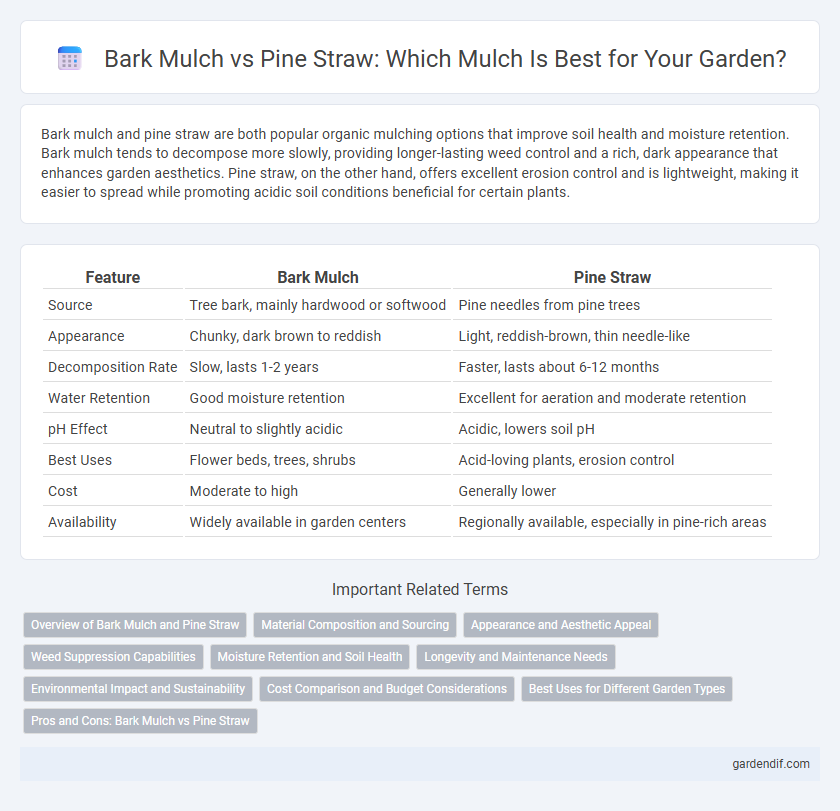
Bark Mulch vs Pine Straw Illustration
Bark mulch and pine straw are both popular organic mulching options that improve soil health and moisture retention. Bark mulch tends to decompose more slowly, providing longer-lasting weed control and a rich, dark appearance that enhances garden aesthetics. Pine straw, on the other hand, offers excellent erosion control and is lightweight, making it easier to spread while promoting acidic soil conditions beneficial for certain plants.
Table of Comparison
| Feature | Bark Mulch | Pine Straw |
|---|---|---|
| Source | Tree bark, mainly hardwood or softwood | Pine needles from pine trees |
| Appearance | Chunky, dark brown to reddish | Light, reddish-brown, thin needle-like |
| Decomposition Rate | Slow, lasts 1-2 years | Faster, lasts about 6-12 months |
| Water Retention | Good moisture retention | Excellent for aeration and moderate retention |
| pH Effect | Neutral to slightly acidic | Acidic, lowers soil pH |
| Best Uses | Flower beds, trees, shrubs | Acid-loving plants, erosion control |
| Cost | Moderate to high | Generally lower |
| Availability | Widely available in garden centers | Regionally available, especially in pine-rich areas |
Overview of Bark Mulch and Pine Straw
Bark mulch consists of shredded or chipped tree bark, offering long-lasting weed suppression and moisture retention with a natural, rustic appearance ideal for landscaping. Pine straw, made from fallen pine needles, provides a lightweight, well-aerated ground cover that decomposes faster, enriching soil with organic matter and is favored in acidic soil regions. Both materials regulate soil temperature and improve plant health, but bark mulch generally lasts longer while pine straw is easier to layer and refresh seasonally.
Material Composition and Sourcing
Bark mulch consists of shredded or chipped tree bark, primarily sourced from hardwood trees such as oak, hickory, or pine, and is often a byproduct of the lumber industry. Pine straw mulch is composed of fallen pine needles collected primarily from longleaf, loblolly, or slash pine species, commonly harvested from pine plantations or forest floors. The sourcing of bark mulch involves recycling timber residuals, while pine straw is a renewable, naturally shed material that requires manual collection, impacting availability and cost.
Appearance and Aesthetic Appeal
Bark mulch provides a rich, earthy texture and deep brown tones that enhance garden beds with a natural, rustic appearance, while pine straw offers a softer, reddish-golden hue that creates a lighter, more delicate aesthetic. The coarse, chunky texture of bark mulch adds visual weight and contrast against green foliage, whereas pine straw's fine, needle-like strands impart a uniform, airy look that complements ornamental plants. Both materials improve landscape appeal, but selection depends on the desired color palette and textural effect for outdoor spaces.
Weed Suppression Capabilities
Bark mulch provides superior weed suppression due to its dense, thick layer that blocks sunlight and inhibits weed seed germination effectively. Pine straw, while offering moderate weed control, tends to be lighter and thinner, allowing some sunlight penetration that can enable weed growth. Choosing bark mulch enhances weed barrier longevity, reducing the need for frequent reapplication and labor.
Moisture Retention and Soil Health
Bark mulch excels in moisture retention due to its dense texture, which reduces evaporation and helps maintain consistent soil moisture levels, promoting healthier plant growth. Pine straw, while lighter and quicker to decompose, provides moderate moisture retention and enhances soil aeration, improving overall soil health by increasing organic matter. Choosing bark mulch or pine straw depends on specific garden needs, with bark mulch favoring long-term moisture conservation and pine straw supporting soil structure and nutrient cycling.
Longevity and Maintenance Needs
Bark mulch typically lasts longer, often maintaining its appearance for up to two years, while pine straw generally requires annual replenishment due to faster decomposition. Bark mulch's dense texture helps suppress weeds and retain moisture more effectively, reducing maintenance frequency compared to the lighter, more dispersible pine straw. Pine straw offers easier installation but demands more frequent replacement to sustain optimal soil protection and aesthetic appeal.
Environmental Impact and Sustainability
Bark mulch, derived from tree bark, is biodegradable and enriches soil as it decomposes, promoting soil health and reducing waste in landfills. Pine straw, harvested sustainably from pine trees without cutting them down, provides excellent erosion control and requires less frequent replacement, lowering environmental impact. Both materials support sustainable landscaping practices by improving water retention and reducing the need for chemical fertilizers.
Cost Comparison and Budget Considerations
Bark mulch generally costs between $30 to $60 per cubic yard, making it a more affordable option for large landscaping projects compared to pine straw, which averages $250 to $450 per bale and requires more frequent replacement. Budget considerations favor bark mulch for extensive ground coverage due to its longer durability, while pine straw's higher initial cost is offset by its natural weed suppression and erosion control benefits. Choosing between bark mulch and pine straw depends on balancing upfront expenses with long-term maintenance and aesthetic preferences.
Best Uses for Different Garden Types
Bark mulch provides excellent moisture retention and weed suppression, making it ideal for perennial flower beds and shrub foundations. Pine straw is lightweight and decomposes faster, suited for acidic soil gardens and areas requiring quick soil warming, such as vegetable patches. Both mulches enhance soil health but their specific benefits align with distinct garden types for optimal growth.
Pros and Cons: Bark Mulch vs Pine Straw
Bark mulch offers long-lasting durability and excellent moisture retention, making it ideal for suppressing weeds and regulating soil temperature, but it can be more expensive and slower to decompose than pine straw. Pine straw provides a natural, lightweight option that improves soil aeration and acidity for acid-loving plants, though it may require more frequent replacement and can be less effective at weed control. Both materials contribute to soil health, but selection depends on garden needs, budget, and plant types.
Bark Mulch vs Pine Straw Infographic

 gardendif.com
gardendif.com